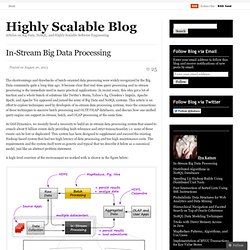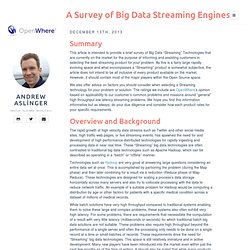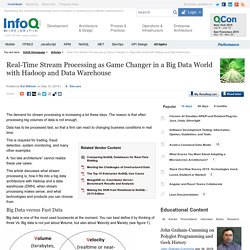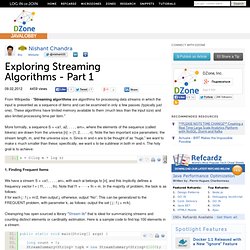

In-Stream Big Data Processing. The shortcomings and drawbacks of batch-oriented data processing were widely recognized by the Big Data community quite a long time ago.

It became clear that real-time query processing and in-stream processing is the immediate need in many practical applications. In recent years, this idea got a lot of traction and a whole bunch of solutions like Twitter’s Storm, Yahoo’s S4, Cloudera’s Impala, Apache Spark, and Apache Tez appeared and joined the army of Big Data and NoSQL systems. This article is an effort to explore techniques used by developers of in-stream data processing systems, trace the connections of these techniques to massive batch processing and OLTP/OLAP databases, and discuss how one unified query engine can support in-stream, batch, and OLAP processing at the same time. A high-level overview of the environment we worked with is shown in the figure below: SQL-like functionality.
The article is based on a research project developed at Grid Dynamics Labs. Pipelining. Introducing SAMOA, an open source platform for mining big data streams. A Survey of Big Data Streaming Engines. Summary This article is intended to provide a brief survey of Big Data “Streaming” Technologies that are currently on the market for the purpose of informing and assisting customers in selecting the best streaming product for your problem.

As this is a fairly large rapidly evolving space and what encompasses a “Streaming” product is somewhat subjective, the article does not intend to be all inclusive of every product available on the market. However, it should contain most of the major players within the Open Source space. We also offer advice on factors you should consider when selecting a Streaming technology for your problem or solution. The ratings we include are OpenWhere’s opinion based on applicability to our customer’s common problems and missions around “general” high throughput low latency streaming problems.
Overview and Background Technologies such as Hadoop are very good at answering large questions considering an entire data set at once. Streaming Requirement Considerations.
Real-Time Stream Processing as Game Changer in a Big Data World with Hadoop and Data Warehouse. The demand for stream processing is increasing a lot these days.

The reason is that often processing big volumes of data is not enough. Data has to be processed fast, so that a firm can react to changing business conditions in real time. This is required for trading, fraud detection, system monitoring, and many other examples. A “too late architecture” cannot realize these use cases. This article discusses what stream processing is, how it fits into a big data architecture with Hadoop and a data warehouse (DWH), when stream processing makes sense, and what technologies and products you can choose from.
IBMInfoSphereStreams-CommoditySample.pdf. 10-jhu1. Exploring Streaming Algorithms - Part 1. From Wikipedia - "Streaming algorithms are algorithms for processing data streams in which the input is presented as a sequence of items and can be examined in only a few passes (typically just one).

These algorithms have limited memory available to them (much less than the input size) and also limited processing time per item. " More formally, a sequence S = <a1, a2, . . . , am>, where the elements of the sequence (called tokens) are drawn from the universe [n] := {1, 2, . . . , n}. Note the two important size parameters: the stream length, m, and the universe size, n. Since m and n are to be thought of as “huge,” we want to make s much smaller than these; specifically, we want s to be sublinear in both m and n. The holy grail is to achieve: 1. Clearspring has open sourced a library "Stream-lib" that is ideal for summarizing streams and counting distinct elements or cardinality estimation. 01.public static void main(String[] args) { 03. long count = 0; 04. Streambook.pdf. Seminar4-online-mining.pdf.
Stream Mining essentials. Real-Time Analytics: Techniques to Analyze and Visualize Streaming Data - Byron Ellis.